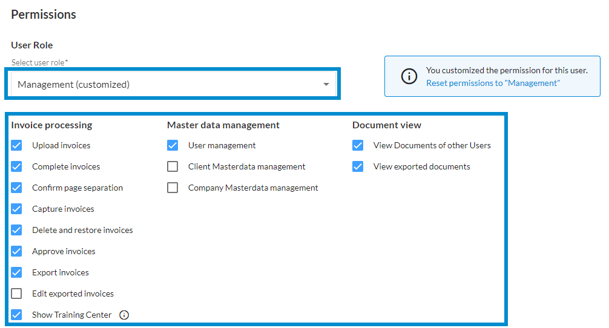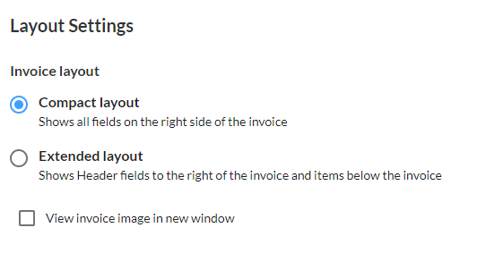How are users managed?
In this article, you will learn how user permissions can be administered.
Content
- Which permissions are required to create and manage users?
- How do I manage users?
- How can I find out how many users there are for my company?
- Which settings can be applied for users?
Which permissions are required to create and manage users?
In order to create users, the authorisation "User management" is required. This article explains how to create users:
How do I manage users?
In the user screen in the main menu, you can use the search bar to search for specific users that you want to manage.

You can then use the three-dot menu in the table view to edit, delete and, if necessary, deactivate users. You also have the option of resetting the password and requesting a security report by e-mail, in which, for example, changes to the user are documented.
It is also possible to set various filters on the right next to the search bar. Further information can be found in How can I filter or adapt the screens?.
You can also access the editing menu by clicking on a user's line.
In the user overview, you can also see the status of the individual users via the table view in the "Status" tab:
- Invite accepted: The invitation link has already been clicked and the user is already activated
- Invited: An invitation has been sent, but has not yet been accepted
- Deactivated: The user has been deactivated and no longer has access to the assigned functions

If you want to delete several users at once, you can do this via the action bar. To do this, select the desired entries and click on the recycle bin symbol.

How can I find out how many users there are for my company?
To do this, open the User-screen and select all users in the table view. Then click on the arrow symbol at the top right and export the selected users as an Excel table.

Which settings can be applied for users?
Various tabs are available in the User-screen for customising users. The user currently being edited is always displayed to the right of ‘Edit user’.

Permissions
The authorisation level determines which screens, clients and their respective invoices can be viewed by users.
Preset User Roles
Selecting a user role automatically assigns its predefined permissions to that user. The permissions which are allocated to each role are detailed below.
-
Accountant
Accountants can upload invoices, confirm page separation, complete and capture invoices, delete and restore invoices, manage client masterdata, view and edit exported invoices, and view invoices of other users. -
Business Admin
Business Admins can upload invoices, confirm page separation, approve invoices, delete and restore invoices, manage users, and view invoices of other users, including exported invoices. -
Management
Management can upload invoices, confirm page separation, complete and capture invoices, delete and restore invoices, manage users, manage client and company masterdata, and view invoices of other users, including exported invoices. -
Upload User
Upload users can upload invoices and confirm page separation. -
Approval User
Approval users can upload invoices, confirm page separation, approve invoices, and view invoices of other users.

Setting individual permissions manually
If you want to customise your user role, the following individual permissions are available to you:
Invoice processing
-
Upload invoices
Allows users to upload and scan invoices to Finmatics. - Complete invoices
Allows users to edit all fields in the invoice detail screen (including accounting fields) of an invoice and enables the “invoices” section on the menu on the left-hand side. -
Confirm page separation
Allows users to edit and confirm the page separation of invoices with the status “separate”. -
Capture invoices
Allows users to edit all non-accounting fields in the invoice detail screen of an invoice to prepare them for accountants. These fields include dates, invoice numbers, transaction figures, and other information which invoices may contain. Items like account numbers cannot be filled out. The “invoices” section on the menu on the left-hand side is also enabled. - Approve invoices
Enables the “Workflow” screen on the left-hand menu, allowing users to see and approve all invoices which they are allowed to approve. To find out more, read our Document approval articles. - Export invoices
Allows users to export invoices. - View Analytics
With this authorisation, you have access to the "Analytics" screen. Please also read How do I use the Analytics Center? - Show Training Center
This permission gives you access to the training screen. You can find more information in What can I do in the training-screen? - Edit exported invoices
Allows users to edit exported invoices.
This permission is particularly important for the synchronisation of client masterdata and training data by API users.
Master data management
- User management
Enables the "Users" screen on the left-hand menu, in which permissions and authorisations can be assigned, as described in this article. - Client Masterdata management
Enables the “Clients” screens on the left-hand menu, in which clients masterdata can be viewed and edited. - Company Masterdata management
Allows users to synchronise and create clients as well as manage company masterdata. To find out more, visit How do I manage my company's information in Finmatics?
This permission is particularly important for the synchronisation of client masterdata and training data by API users.
Document view
- View Documents of other Users
Allows users, within any restrictions caused by other set permissions, to view invoices other users have uploaded. - View exported invoices
Allows users to view exported invoices.

If you want to reset the current role to the default settings, you can do this at any time by clicking on "Reset permissions"

Manage document permissions
Here you can assign users at company, client or process level. It is possible to assign one or more users (company, client, process) to the respective user at any level. To do this, open the drop-down menu. In the field selection, you can search for the corresponding objects in the search bar and then, for example, assign one client and one or two processes to a user.

Company / Holding
This assigns company-wide authorisations. If a company is assigned here, the user has access to all the clients assigned to that company as well as their invoices
Client
If a users should only have access to specific clients and their invoices, the level of authorisation can be adjusted here to assign those clients.
Process
If a users should only have access to specific processes, or specific processes of specific clients, the level of authorisation can be adjusted further here.
In the field selection, you can search by company, client or process in the search bar, depending on the role assigned.
Profile
In this tab, you can define general settings such as salutation, name, language and contact details.

Notifications
Information on configuring notifications can be found in How do I use the User Menu? under "Notifications".
Layout
Information on the layout options can be found in How do I use the User Menu? under "Layout".

Suggested settings for staff and client permissions
Clients
-
Authorisation: Client
-
Permissions: Upload
These settings allow a client to scan/upload their invoices into the online portal and only see invoices that have been uploaded by their user. The permission "View documents of other users" can also be set to allow the client to see all invoices (and their statuses) company-wide. If the client is to separate and/or complete their own invoices, these permissions can also be set.
If the client should only upload certain types of invoices, these can also be selected individually in the Assignments section.
Secretary
-
Authorisation: Company-wide
-
Permissions: Upload, Confirm page separation
These settings allow an employee to upload invoices for all of the company's clients as well as to check and confirm the page separation for all of their uploaded invoices. If an employee should also be able to work with invoices other users have uploaded, the permission "View documents of other users" can be set. If these invoices should also be completed, "Complete documents" can also be set.
If the employee should only be scanning and/or completing invoices for specific clients, these can also be selected individually in the Assignments section.
Accountant
-
Authorisation: Company-wide
-
Permissions: View documents of other users, Upload, Confirm page separation, Complete invoices, Capture invoices
These settings allow an employee to view the invoices of all clients across company and edit them regardless of status. If the accountant should also be able to invite and manage clients, "Client master data management" can also be set.
If the employee should only do the accounting for specific clients, these can also be selected individually in the Assignments section.
Administrator
-
Authorisation: Company-wide
-
Permissions: All
For administrators, it is usually advisable to assign all permissions at the company level, so that they can manage users without restriction.
Restrictions can serve a purpose here too. The most essential permissions for administrators are user management and client master data management.